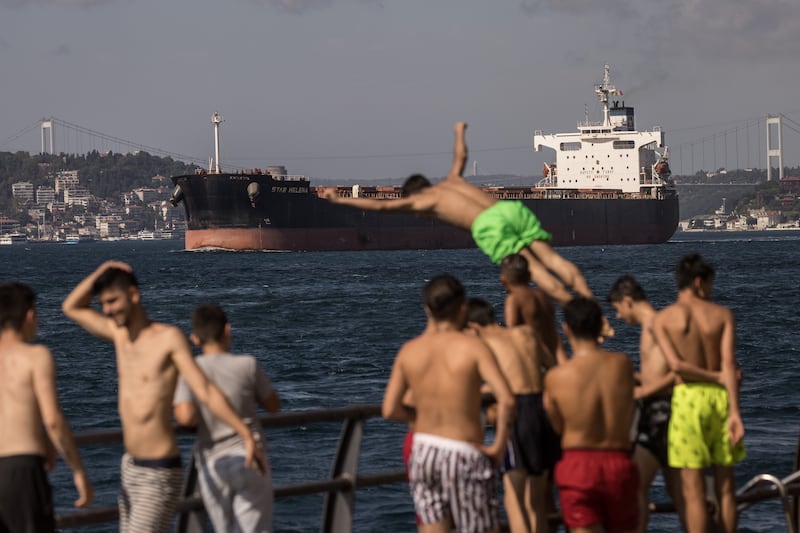To the sound of cheering, the Razoni slipped out of its moorings on August 1st with its horn blaring – the first ship to leave the Ukrainian port of Odesa after a blockade of almost six months at the hands of the Russian navy.
“These are the sounds of a working port,” said mayor Gennadiy Trukhanov. “It’s difficult for the city to live without these sounds.”
Ships were stranded in Odesa and Ukraine’s other Black Sea ports after Russia’s full-scale invasion began in February, caught between the country’s defensive sea mines and the Russian navy. Global food prices leapt as one of the most crucial international supply routes for grain was choked off – and Odesa, Ukraine’s most important port, was deprived of much of its livelihood.
“When the port shut down due to the war, it felt like not just the windows were closed, but also the shutters,” said Trukhanov.
[ ‘Putin thought Odesa would welcome him with bread and salt’Opens in new window ]
About 200,000 residents fled the city in the first weeks of the war, many to nearby Moldova or further into Europe. In the following months Russian missiles repeatedly hit targets in Odesa, killing civilians and destroying the runway at the airport.
But with the signing of a multilateral humanitarian agreement to free shipping lanes to get food to global markets last month, a tentative optimism has returned.
About 30 vessels have traversed the narrow corridor in and out of Odesa since the Black Sea Grain Initiative, brokered by Turkey’s Recep Tayyip Erdogan, the UN, Russia and Ukraine, was agreed on July 22nd. On Friday, UN secretary general António Guterres is visiting Odesa, in a sign of hope that the deal will hold.
Ships are now escorted by Ukrainian tugboat captains through a narrow maritime corridor to the edge of the minefield planted by Ukrainian forces before heading to Istanbul to be cleared for their final routes.

The grain deal has raised hopes that Odesa, established as a freeport by Russia’s Catherine the Great at the end of the 18th century, will survive the war without suffering the destruction of other Ukrainian cities under assault from Russia’s president Vladimir Putin.
“The port is the source of Odesa’s wealth, and the reason that Odesa exists,” said Roman Morgenstern, a director at Ukrferry, which had two cargo and passenger ferries that plied the waters between Odesa and Istanbul trapped when the war began. “For us, it was a mortal hit. Hundreds of employees, a big organisation we had built up over 25 years – what should we do in these circumstances?”
With the blockade partially lifted and the war’s frontline two hours away, Odesa’s port is preparing for a slow restoration of activities, even though threat remains. Four missiles slammed into the port on July 24th, hitting what the Russian foreign ministry described as a Ukrainian military boat.
The blockade severely hit Ukraine’s economy. The vast majority of the country’s exports by value, including steel, used the port of Odesa and its two smaller neighbours, also blockaded, to reach faraway markets.

The port is also critical for Ukraine’s farmers. Until war erupted, it was the centre of a logistics network that took millions of tonnes of grain from its fertile, black soil “breadbasket” to the Black Sea, from where it was exported as far as Africa and south-east Asia.
With ports blockaded, grain silos inside the country were full and the local market for food deliveries collapsed, leaving farmers unsure if they would recoup their costs if they planted a crop this autumn.
“When the seaports were closed, the price for local production made no sense for the winter planting,” said Taras Kachka, Ukraine’s junior economy minister and chief trade negotiator. A small fraction of Ukraine’s usual exports were transported by road, rail and even along the Danube river but “logistics ate up all the profits”, said Kachka.
An estimated 20 million tons of grains remain trapped in inland silos. However, the owner of one trucking company said he had already rerouted some vehicles from overland routes to Poland in the expectation that farmers would start booking deliveries to the port.
The grain deal has been described as a humanitarian gesture by Russia, which has promised not to fire upon ships in exchange for joint inspections with Turkish and Ukrainian officials to check for weapons.
[ Odesa and Russia: ‘First they send a ballerina. Then they send a tank’Opens in new window ]
But the clogged arteries of the crucial logistics network are taking time to clear. Dozens of ships still need to find their way out of port and not all are covered by the grain initiative, which only applies to food and fertiliser.
Gaurav Srivastava, chair of trader Harvest Commodities, watched in relief as two of the companies’ ships finally left the ports of Odesa and Chornomorsk carrying about 100,000 tonnes of corn.
Srivastava said things had been “really tough” psychologically for the crews trapped on board. “Very quickly, this became a humanitarian issue – for the crew, for the farmers, for the world.”
Until more trapped vessels leave there will be no space for more ships to dock and pick up grain. And the war still looms over hopes for Odesa’s revival. “I can’t plan even one day in advance,” said Trukhanov, the mayor. “How can one talk about restoring the city when things are still precarious – we can’t even find enough crews for the ships, even if the port is somewhat open.”
Ukrferry’s Morgenstern has been considering an idea to stack bags of grain in the cargo decks and filling trucks with grain and loading them on to the cargo holds. He is not sure if the plan will work, but he is hopeful.
“For now, it’s only grain that’s allowed, but if we don’t get our vessels out, we have no market, no ability to make a return on our investments,” he said. “Suddenly, with this deal, it’s like we finally have some air in our lungs.” – Copyright The Financial Times Limited 2022








